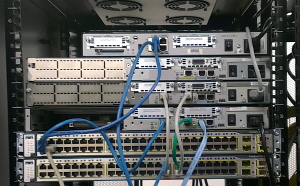Final Preparations for the CCNA Exam / Building my CCNA/CCNP lab
So I finally decided to take the CCNA exam – 12 years after going through a great portion of the topics during my training as an IT professional.
Since my vocational college was (and still is) a Cisco Networking Academy (1999-2003) we used the Curriculum as a part of our daily lectures and they have given me both the knowledge and the motivation to dig into one of my favorite areas of IT engineering.
Back when I set up my first 10Base2 Local Area Network at the age of 15 – I knew practically nothing about IP Adresses and how to deploy them correctly. At some point, I got the 192.168.1.1/255.255.255.0 thing right and Local Area Network gaming opened up a whole new world to us. Keep in mind, back then most of the kids our age had only limited access to the internet.
Together with the GNU/Linux Operating System networks not only became my profession, but also my passion.
The last few years I spent with designing, implementing and troubleshooting medium sized networks in a university campus environment. After recently planning and deploying a medium sized wireless network (130 Lightweight Access Points) my next 2 candidates on the list of exploration (and at some point perhaps mastering) will be BGP and MPLS at a CCNP level, so I might as well take the CCNA on my path and then go for the CCNP. Even with many years of experience the CCNA exam will definitely not be a cakewalk since there are always some gaps that need to be filled (Frame-Relay, y u no go extinct!) and the exam yet has a reputation to be hard.
My Lab is still missing some WIC-1T cards + DCE/DTE crossover cables but then i should be good to go.
Hacking Customer Quality Assurance
So I recently bought some (refurbished) Cisco equipment for my CCNA/CCNP lab, a 2620 and a 2621 to be precise. I bought both of them from the same company although there was a small, but important difference.
The 2620 placed in my first order went to my home address, but since I am building the Lab at my office I decided to have the 2621 shipped to my company address to spare me the logistics. Turned out this decision made quite a difference when both products arrived. (I bought the 2620 about 5 days ahead).
The 2620 could not boot the default IOS due to the following error:
System Bootstrap, Version 11.3(2)XA4, RELEASE SOFTWARE (fc1) Copyright (c) 1999 by cisco Systems, Inc. TAC:Home:SW:IOS:Specials for info C2600 platform with 16384 Kbytes of main memory program load complete, entry point: 0x80008000, size: 0x403b9c Self decompressing the image : #####....] INSUFFICIENT MEMORY TO LOAD IMAGE! I/O memory percentage cannot be adjusted.
Checking the Cisco IOS Image downloads I noticed the requirements for the IOS Image on the shipped 2620 requires at least 32MB DRAM, like any other 2620 image listed there (bare minimum is 32MB Dram,8 MB flash). However the Router was only equipped with 16MB of DRAM making the Router unusable, even with the minimum feature IOS for the 2620.
Now since the Hardware was probably refurbished, it is clear that some memory was replaced/removed but not in a fashion that allows the Router to boot the IOS Image. Looks like somebody did not even boot up the Router to see if it works. Probably a mistake (to err is human, after all).
When my 2621 arrived (addressed to my company address) the package also included a “Testing Protocol” – basically a show version printed on a piece of paper. Someone actually took the time to boot it up, connect to the console port and copy & paste the output to add the print along with the product. As a customer, this ensures me that someone took the time to verify the functionality of the Router.
I do not now if that was just coincidence but it does seem to verify that depending on the shipping address quality assurance is handled differently. I will post an update on the situation.
But looks like the tl;dr of the whole story is: Use a corporate address if you can.
New top500.org list released
http://www.top500.org/statistics/list/
As it comes to no surprise, Linux totally dominates on this field.
| Operating system Family | Count | System Share (%) | Rmax (GFlops) | Rpeak (GFlops) | Cores |
| Linux | 469 | 93.8 | 155667628 | 221440076 | 14109948 |
| Unix | 20 | 4 | 4264437 | 5326824 | 200096 |
| Mixed | 7 | 1.4 | 1453422 | 1749811 | 528384 |
| Windows | 3 | 0.6 | 465600 | 628129 | 46092 |
| BSD Based | 1 | 0.2 | 122400 | 131072 | 1280 |
Networking Cheat sheets
I am currently studying for my CCNA and would like to share some cheat sheets with you. They can be found at http://packetlife.net/library/cheat-sheets/
You will find cheat sheets for all kinds of network related topics such as:
- IEEE 802.11
- IPsec
- IEEE 802.1x
- IPv6
- OSPF
- Spanning Tree


